RS Content and eGI Value of Cooked Noodles (I): Effect of Cooking Methods
Abstract
1. Introduction
2. Materials and Methods
2.1. Materials
2.2. Preparation of Noodles
2.3. Preparation of Cooked Noodles
2.4. The Moisture Content of Cooked Noodles
2.5. Wide-Angle X-ray Diffraction Patterns (XRD)
2.6. Differential Scanning Calorimetry (DSC)
2.7. Scanning Electron Microscope (SEM)
2.8. Determination of RS Content
2.9. In Vitro Starch Digestibility
2.10. Calculation of the Estimated Glycemic Index (eGI)
3. Results
3.1. Effects of Cooking Conditions on the RS Content of Noodles
3.2. Effects of Different Cooking Methods on the in Vitro Starch Digestibility and Estimated Glycemic Index of Noodles
3.3. Thermal Transitions and Crystalline Structure of Starch in Noodles Cooked using Different Methods
3.4. The Morphology of Noodles Cooked Using Different Methods
4. Discussion
5. Conclusions
Supplementary Materials
Author Contributions
Funding
Acknowledgments
Conflicts of Interest
References
- Li, M.; Dhital, S.; Wei, Y. Multilevel structure of wheat starch and its relationship to noodle eating qualities. Compr. Rev. Food Sci. Food Saf. 2017, 16, 1042–1055. [Google Scholar] [CrossRef]
- Englyst, H.N.; Kingman, S.M.; Cummings, J.H. Classification and measurement of nutritionally important starch fractions. Eur. J. Clin. Nutr. 1992, 46, S33–S50. [Google Scholar]
- Brown, I.L. Applications and uses of resistant starch. J. AOAC Int. 2004, 87, 727–732. [Google Scholar] [CrossRef] [PubMed]
- van Munster, I.P.; Tangerman, A.; Nagengast, F.M. Effect of resistant starch on colonic fermentation, bile acid metabolism, and mucosal proliferation. Dig. Dis. Sci. 1994, 39, 834–842. [Google Scholar] [CrossRef]
- Raigond, P.; Ezekiel, R.; Raigond, B. Resistant starch in food: A review. J. Sci. Food Agric. 2015, 95, 1968–1978. [Google Scholar] [CrossRef] [PubMed]
- Birt, D.F.; Boylston, T.; Hendrich, S.; Jane, J.L.; Hollis, J.; Li, L.; Mcclelland, J.; Moore, S.; Phillips, G.J.; Rowling, M. Resistant Starch: Promise for Improving Human Health. Adv. Nutr. 2013, 4, 587–601. [Google Scholar] [CrossRef] [PubMed]
- Dhital, S.; Warren, F.J.; Butterworth, P.J.; Ellis, P.R.; Gidley, M.J. Mechanisms of starch digestion by α-amylase—Structural basis for kinetic properties. Crit. Rev. Food Sci. Nutr. 2017, 57, 875–892. [Google Scholar] [CrossRef] [PubMed]
- Vaidya, R.H. Processing and storage of Indian cereal and cereal products alters its resistant starch content. J. Food Sci. Technol. 2011, 48, 622–627. [Google Scholar] [CrossRef]
- Yao, M.; Li, M.; Dhital, S.; Tian, Y.; Guo, B. Texture and digestion of noodles with varied gluten contents and cooking time: The view from protein matrix and inner structure. Food Chem. 2020, 315, 126230. [Google Scholar] [CrossRef]
- Singh, J.; Dartois, A.; Kaur, L. Starch digestibility in food matrix: A review. Trends Food Sci. Technol. 2010, 21, 168–180. [Google Scholar] [CrossRef]
- Liu, K.; Han, J. Enzymatic method for measuring starch gelatinization in dry products in situ. J. Agric. Food Chem. 2012, 60, 4212–4221. [Google Scholar] [CrossRef] [PubMed]
- Dhital, S.; Brennan, C.; Gidley, M.J. Location and interactions of starches in planta: Effects on food and nutritional functionality. Trends Food Sci. Technol. 2019. [Google Scholar] [CrossRef]
- Goñi, I.; Garcia-Alonso, A.; Saura-Calixto, F. A starch hydrolysis procedure to estimate glycemic index. Nutr. Res. 1997, 17, 427–437. [Google Scholar] [CrossRef]
- Foster-Powell, K.; Holt, S.H.; Brand-Miller, J.C. International table of glycemic index and glycemic load values: 2002. Am. J. Clin. Nutr. 2002, 76, 5–56. [Google Scholar] [CrossRef] [PubMed]
- Capriles, V.D.; Arêas, J.A.G. Approaches to reduce the glycemic response of gluten-free products: In vivo and in vitro studies. Food Funct. 2016, 7, 1266–1272. [Google Scholar] [CrossRef]
- Atkinson, F.S.; Foster-Powell, K.; Brand-Miller, J.C. International tables of glycemic index and glycemic load values: 2008. Diabetes Care 2008. [Google Scholar] [CrossRef]
- Jia, B.; Yao, Y.; Liu, J.; Guan, W.; Brennan, C.S.; Brennan, M.A. Physical properties and in vitro starch digestibility of noodles substituted with tartary buckwheat flour. Starch-Stärke 2019, 71, 1800314. [Google Scholar] [CrossRef]
- Saito, H.; Tamura, M.; Ogawa, Y. Starch digestibility of various Japanese commercial noodles made from different starch sources. Food Chem. 2019, 283, 390–396. [Google Scholar] [CrossRef]
- Tang, A.; Li, M.; Wang, R.; Dhital, S.; Lu, D. Manipulating raw noodle crystallinity to control the hardness of cooked noodle. LWT 2019, 109, 305–312. [Google Scholar] [CrossRef]
- Li, M.; Hasjim, J.; Xie, F.; Halley, P.J.; Gilbert, R.G. Shear degradation of molecular, crystalline, and granular structures of starch during extrusion. Starch-Stärke 2014, 66, 595–605. [Google Scholar] [CrossRef]
- Teng, A.; Witt, T.; Wang, K.; Li, M.; Hasjim, J. Molecular rearrangement of waxy and normal maize starch granules during in vitro digestion. Carbohydr. Polym. 2016, 139, 10–19. [Google Scholar] [CrossRef] [PubMed]
- McCleary, B.V.; Monaghan, D.A. Measurement of resistant starch. J. Aoac Int. 2002, 85, 665–675. [Google Scholar] [CrossRef] [PubMed]
- Wang, K.; Hasjim, J.; Wu, A.C.; Henry, R.J.; Gilbert, R.G. Variation in Amylose Fine Structure of Starches from Different Botanical Sources. J. Agric. Food Chem. 2014, 62, 4443–4453. [Google Scholar] [CrossRef] [PubMed]
- Butterworth, P.J.; Warren, F.J.; Grassby, T.; Patel, H.; Ellis, P.R. Analysis of starch amylolysis using plots for first-order kinetics. Carbohydr. Polym. 2012, 87, 2189–2197. [Google Scholar] [CrossRef]
- Edwards, C.H.; Warren, F.J.; Milligan, P.J.; Butterworth, P.J.; Ellis, P.R. A novel method for classifying starch digestion by modelling the amylolysis of plant foods using first-order enzyme kinetic principles. Food Funct. 2014, 5, 2751–2758. [Google Scholar] [CrossRef]
- Wang, S.; Copeland, L. Molecular disassembly of starch granules during gelatinization and its effect on starch digestibility: A review. Food Funct. 2013, 4, 1564–1580. [Google Scholar] [CrossRef]
- Yang, Y.; Wang, L.; Li, Y.; Qian, H.F.; Zhang, H.; Wu, G.C.; Qi, X.G. Investigation the molecular degradation, starch-lipid complexes formation and pasting properties of wheat starch in instant noodles during deep-frying treatment. Food Chem. 2019, 283, 287–293. [Google Scholar] [CrossRef]
- Reed, M.O.; Ai, Y.; Leutcher, J.L.; Jane, J.L. Effects of cooking methods and starch structures on starch hydrolysis rates of rice. J. Food Sci. 2013, 78, H1076–H1081. [Google Scholar] [CrossRef]
- Gunaratne, A.; Ranaweera, S.; Corke, H. Thermal, pasting, and gelling properties of wheat and potato starches in the presence of sucrose, glucose, glycerol, and hydroxypropyl β-cyclodextrin. Carbohydr. Polym. 2007, 70, 112–122. [Google Scholar] [CrossRef]
- de Dios Figueroa-Cárdenas, J.; Véles-Medina, J.J.; Esquivel-Martínez, A.M.; Mariscal-Moreno, R.M.; Santiago-Ramos, D.; Hernández-Estrada, Z.J. Effect of processing procedure on the formation of resistant starch in tamales. Starch-Stärke 2016, 68, 1121–1128. [Google Scholar] [CrossRef]
- Wang, S.; Wang, J.; Yu, J.; Wang, S. Effect of fatty acids on functional properties of normal wheat and waxy wheat starches: A structural basis. Food Chem. 2016, 190, 285–292. [Google Scholar] [CrossRef] [PubMed]
- Chen, X.; He, X.; Fu, X.; Zhang, B.; Huang, Q. Complexation of rice starch/flour and maize oil through heat moisture treatment: Structural, in vitro digestion and physicochemical properties. Int. J. Biol. Macromol. 2017, 98, 557–564. [Google Scholar] [CrossRef] [PubMed]
- Ai, Y.; Hasjim, J.; Jane, J.L. Effects of lipids on enzymatic hydrolysis and physical properties of starch. Carbohydr. Polym. 2013, 92, 120–127. [Google Scholar] [CrossRef] [PubMed]
- Kojima, T.I.; Horigane, A.K.; Yoshida, M.; Nagata, T.; Nagasawa, A. Change in the status of water in Japanese noodles during and after boiling observed by NMR micro imaging. J. Food Sci. 2001, 66, 1361–1365. [Google Scholar] [CrossRef]
- Moss, R.; Gore, P.; Murray, I. The influence of ingredients and processing variables on the quality and microstructure of Hokkien, Cantonese and instant noodles. Food Struct. 1987, 6, 9. [Google Scholar]
- Heo, S.; Lee, S.M.; Bae, I.Y.; Park, H.-G.; Lee, H.G.; Lee, S. Effect of Lentinus edodes β-glucan-enriched materials on the textural, rheological, and oil-resisting properties of instant fried noodles. Food Bioprocess Technol. 2013, 6, 553–560. [Google Scholar] [CrossRef]
- Sekine, M.; Harada, K. Changes in properties and microstructure of noodles during boiling process. Nippon Shokuhin Kogyo Gakkaishi 1990, 37, 454–457. [Google Scholar] [CrossRef][Green Version]
- Wang, W.; Deng, L.; Zhou, S.; Li, Y.; Wang, L.; Qian, H.; Zhang, H.; Qi, X. Effect of Whole Wheat Flour on the Deep-frying Kinetics of Chinese Sachima. J. Food and Nutr. Res. 2018, 6, 277–284. [Google Scholar]
- Goebel, N.; Grider, J.; Davis, E.; Gordon, J. The effects of microwave energy and convection heating on wheat starch granule transformations. Food Struct. 1984, 3, 10. [Google Scholar]
- Anderson, A.K.; Guraya, H.S. Effects of microwave heat-moisture treatment on properties of waxy and non-waxy rice starches. Food Chem. 2006, 97, 318–323. [Google Scholar] [CrossRef]
- Dreher, M.L.; Dreher, C.J.; Berry, J.W.; Fleming, S.E. Starch digestibility of foods: A nutritional perspective. Crit. Rev. Food Sci. Nutr. 1984, 20, 47–71. [Google Scholar] [CrossRef] [PubMed]
- Bilbao-Sáinz, C.; Butler, M.; Weaver, T.; Bent, J. Wheat starch gelatinization under microwave irradiation and conduction heating. Carbohydr. Polym. 2007, 69, 224–232. [Google Scholar] [CrossRef]
- Morrison, W. Starch lipids and how they related to starch granule structure and functionality. Cereal Foods World 1995, 40, 437–446. [Google Scholar]
- Zhang, G.; Hamaker, B.R. Starch-free fatty acid complexation in the presence of whey protein. Carbohydr. Polym. 2004, 55, 419–424. [Google Scholar] [CrossRef]
- Singh Yadav, B. Effect of frying, baking and storage conditions on resistant starch content of foods. Br. Food J. 2011, 113, 710–719. [Google Scholar] [CrossRef]
- Hasjim, J.; Jane, J.L. Production of resistant starch by extrusion cooking of acid-modified normal-maize starch. J. Food Sci. 2009, 74, C556–C562. [Google Scholar] [CrossRef] [PubMed]
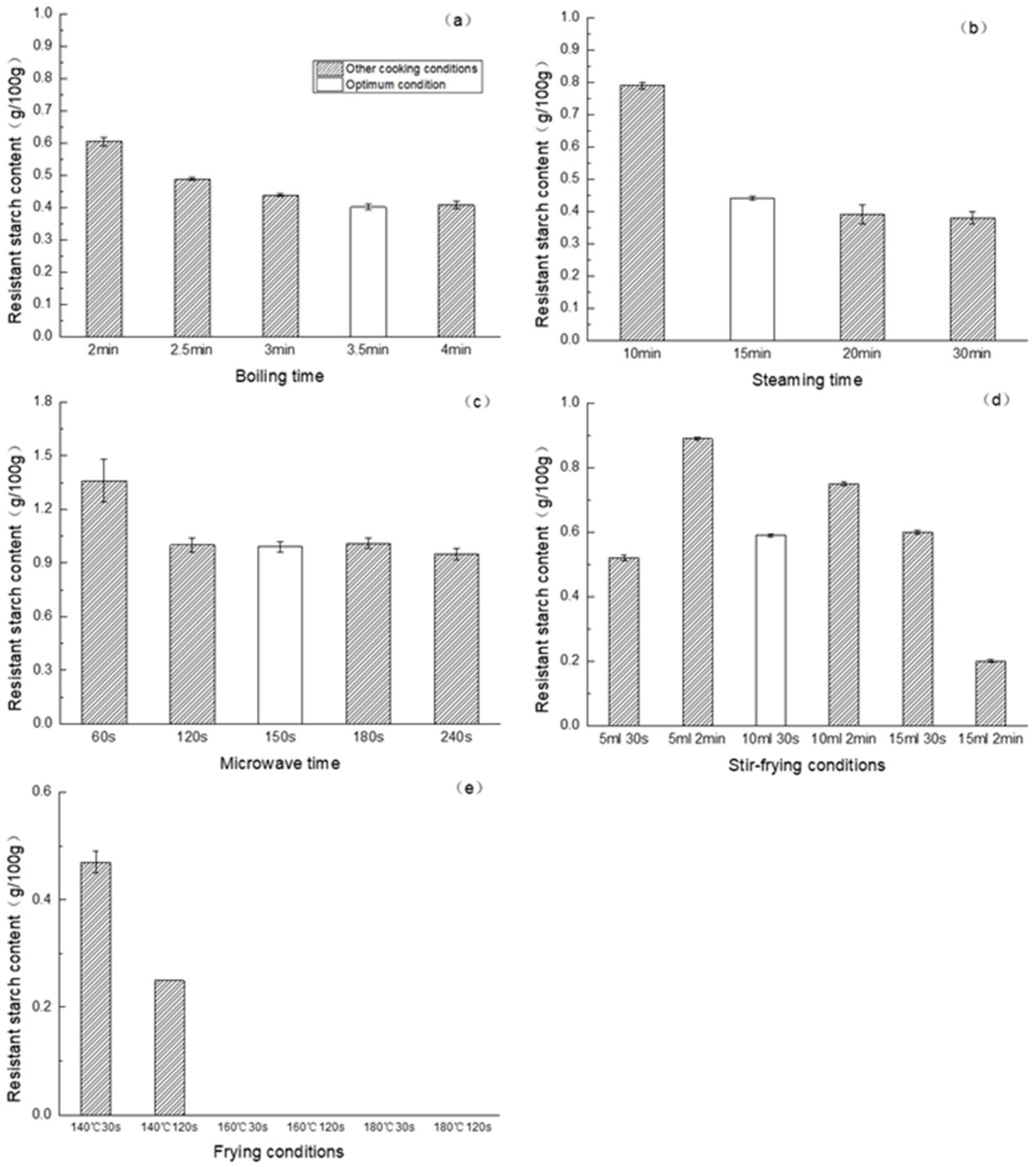
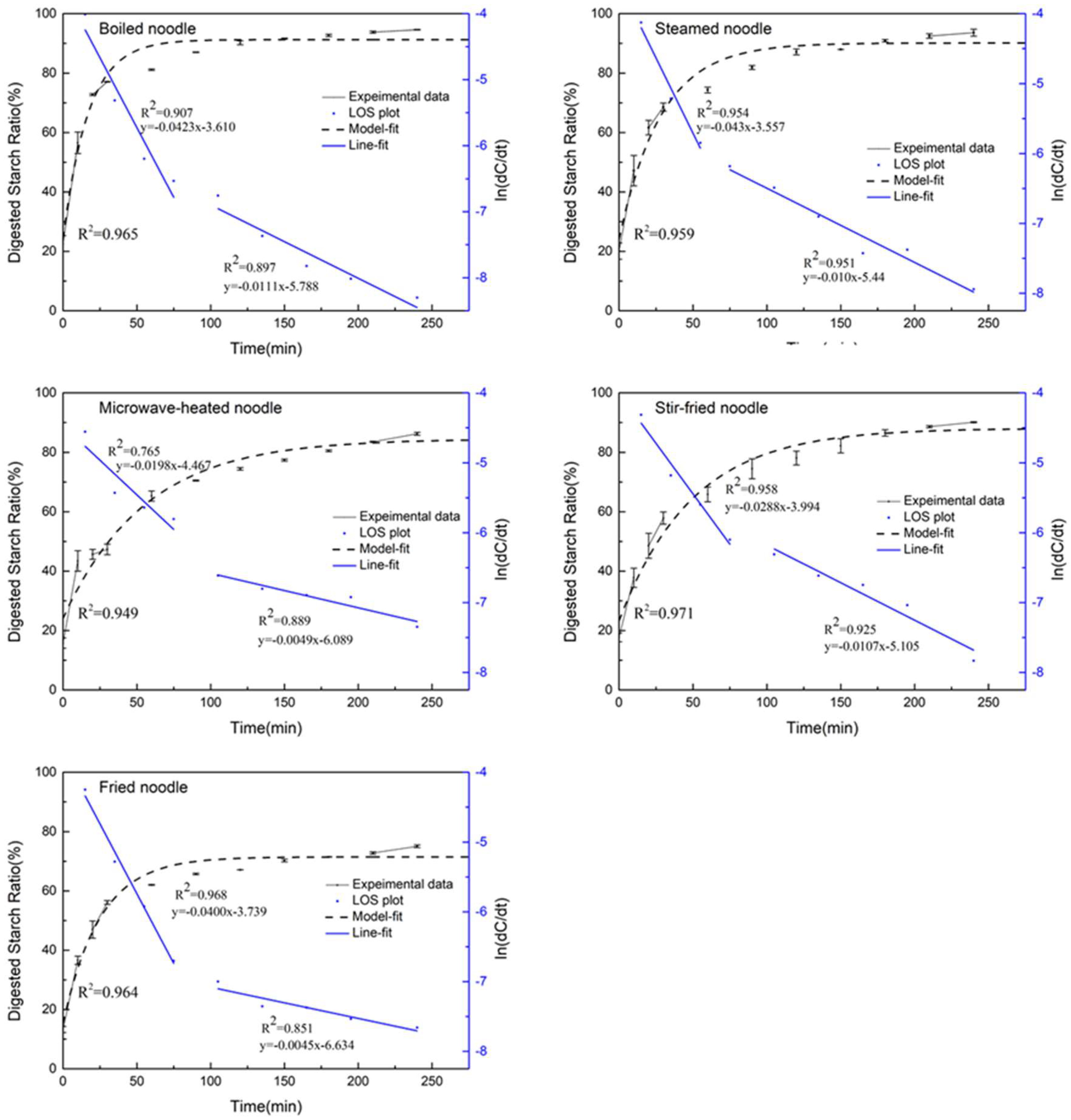
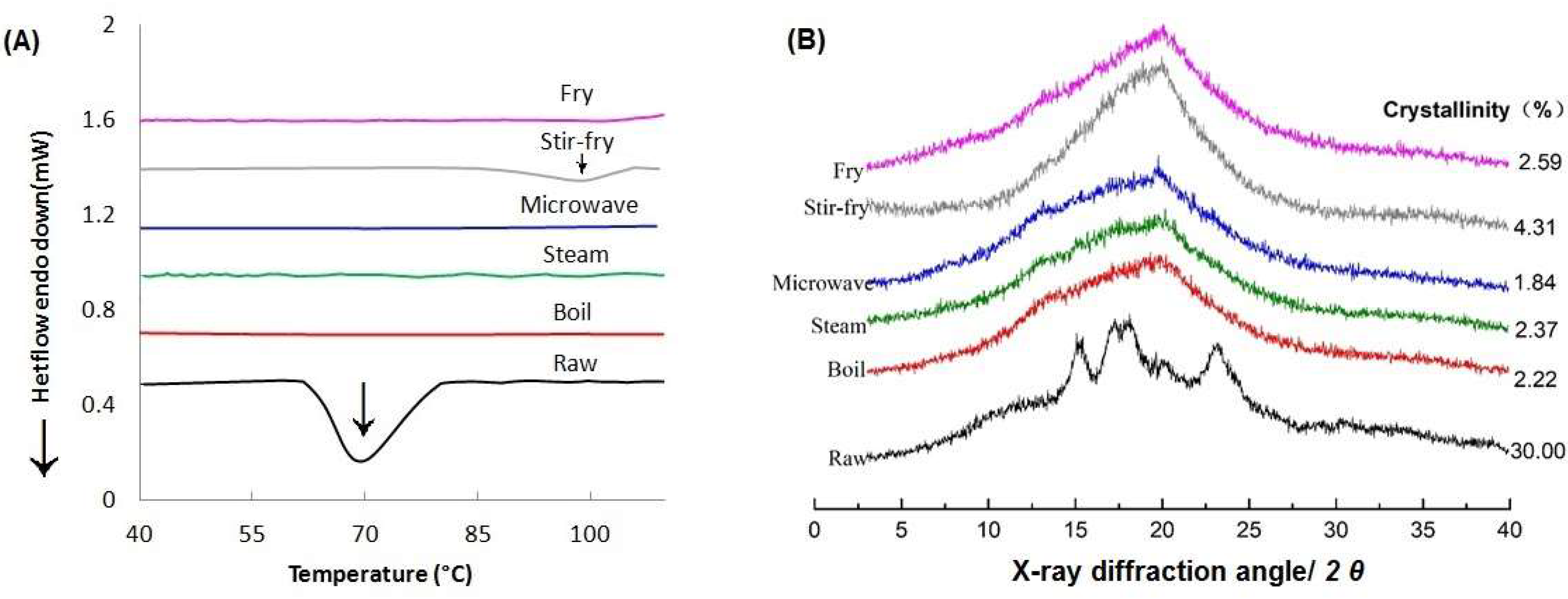
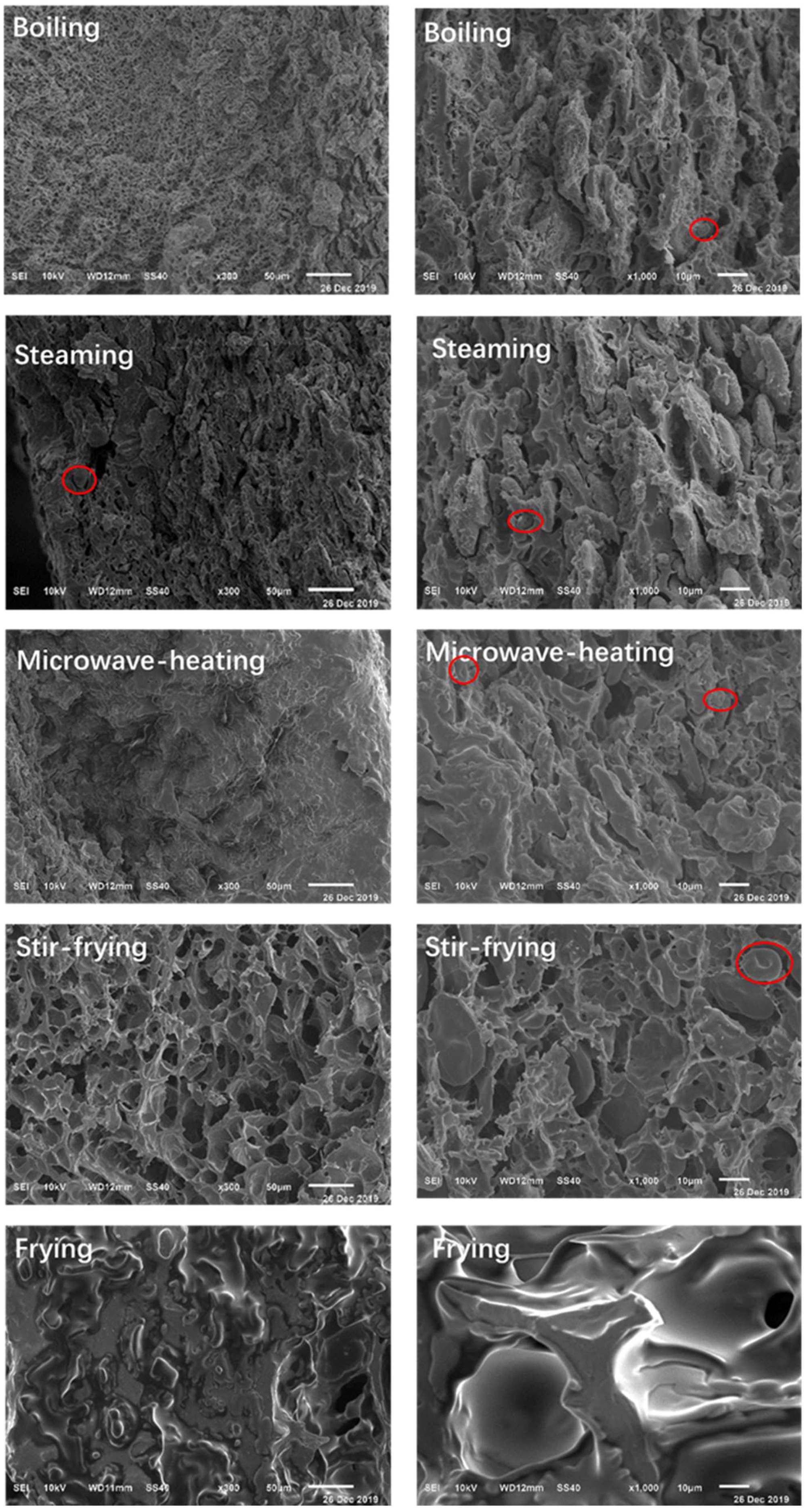
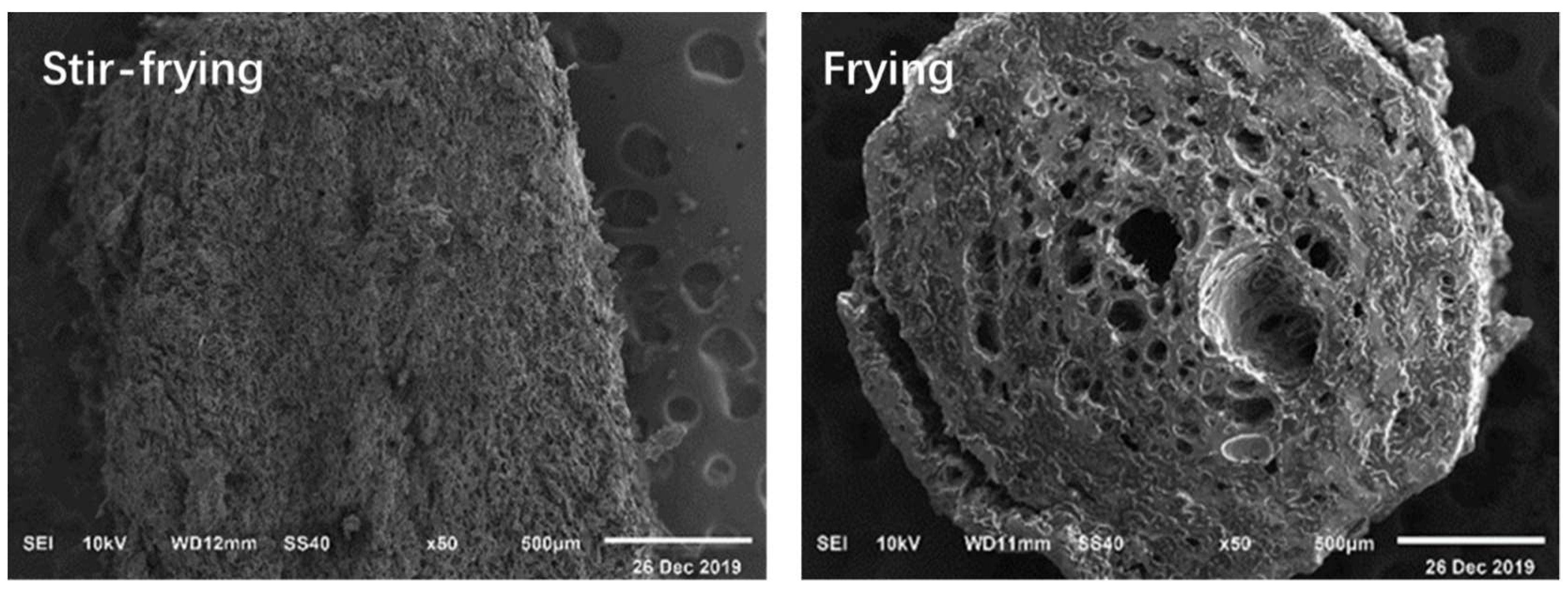
| Cooking Method | Moisture Content/% | To (°C) | Tp (°C) | Tc (°C) | △H (J/g) | RS Content/% |
|---|---|---|---|---|---|---|
| Raw | 12.79 ± 0.35 e | 63.13 ± 0.65 b | 69.61 ± 0.08 b | 80.69 ± 0.86 c | 4.55 ± 0.98 a | 13.83 ± 0.12 a |
| Boiling | 67.69 ± 0.17 a | - | - | - | - | 0.43 ± 0.01 c |
| Steaming | 55.50 ± 1.28 c | 86.05 ± 1.41 a | 99.10 ± 0.08 a | 109.84 ± 0.01 a | 0.38 ± 0.08 b | 0.44 ± 0.01 c |
| Microwave heating | 63.68 ± 1.52 b | - | - | - | - | 0.99 ± 0.05 a |
| Stir-frying | 52.42 ± 0.79 c | 88.39 ± 4.54 a | 97.74 ± 0.82 a | 104.20 ± 2.74 b | 0.84 ± 0.95 b | 0.59 ± 0.01 c |
| Frying | 0.67 ± 0.03 d | - | - | - | - | 0 d |
| Cooking Methods | k1(min−1) | k2(min−1) | C∞ (%) | HI | eGI |
|---|---|---|---|---|---|
| Boiling | 0.0411 ± 0.002 a | 0.0110 ± 0.0002 a | 96.22 ± 0.76 a | 106.78 ± 0.53 a | 98.33 ± 0.29 a |
| Steaming | 0.0354 ± 0.002 b | 0.0111 ± 0.0009 a | 94.22 ± 1.42 a | 101.71 ± 0.19 a | 95.55 ± 0.11 a |
| Microwave-heating | 0.0202 ± 0.000 c | 0.0054 ± 0.0004 b | 88.71 ± 0.67 c | 86.01 ± 1.57 c | 86.93 ± 0.86 c |
| Stir-frying | 0.0290 ± 0.001 d | 0.0127 ± 0.0020 a | 91.53 ± 0.35 b | 92.43 ± 2.80 b | 90.46 ± 1.54 b |
| Frying | 0.0423 ± 0.003 a | 0.0041 ± 0.0004 b | 77.48 ± 0.50 d | 84.64 ± 1.36 c | 86.18 ± 0.75 c |
| RS Content | |
|---|---|
| C∞ | 0.012 |
| k1 | −0.924 ** |
© 2020 by the authors. Licensee MDPI, Basel, Switzerland. This article is an open access article distributed under the terms and conditions of the Creative Commons Attribution (CC BY) license (http://creativecommons.org/licenses/by/4.0/).
Share and Cite
Tian, Y.; Li, M.; Tang, A.; Jane, J.-L.; Dhital, S.; Guo, B. RS Content and eGI Value of Cooked Noodles (I): Effect of Cooking Methods. Foods 2020, 9, 328. https://doi.org/10.3390/foods9030328
Tian Y, Li M, Tang A, Jane J-L, Dhital S, Guo B. RS Content and eGI Value of Cooked Noodles (I): Effect of Cooking Methods. Foods. 2020; 9(3):328. https://doi.org/10.3390/foods9030328
Chicago/Turabian StyleTian, Yu, Ming Li, Aoxing Tang, Jay-Lin Jane, Sushil Dhital, and Boli Guo. 2020. "RS Content and eGI Value of Cooked Noodles (I): Effect of Cooking Methods" Foods 9, no. 3: 328. https://doi.org/10.3390/foods9030328
APA StyleTian, Y., Li, M., Tang, A., Jane, J.-L., Dhital, S., & Guo, B. (2020). RS Content and eGI Value of Cooked Noodles (I): Effect of Cooking Methods. Foods, 9(3), 328. https://doi.org/10.3390/foods9030328




